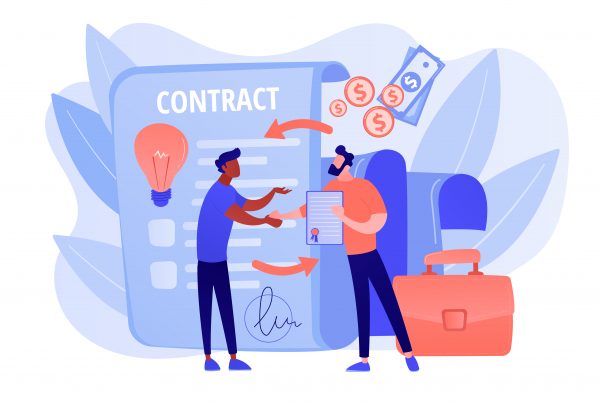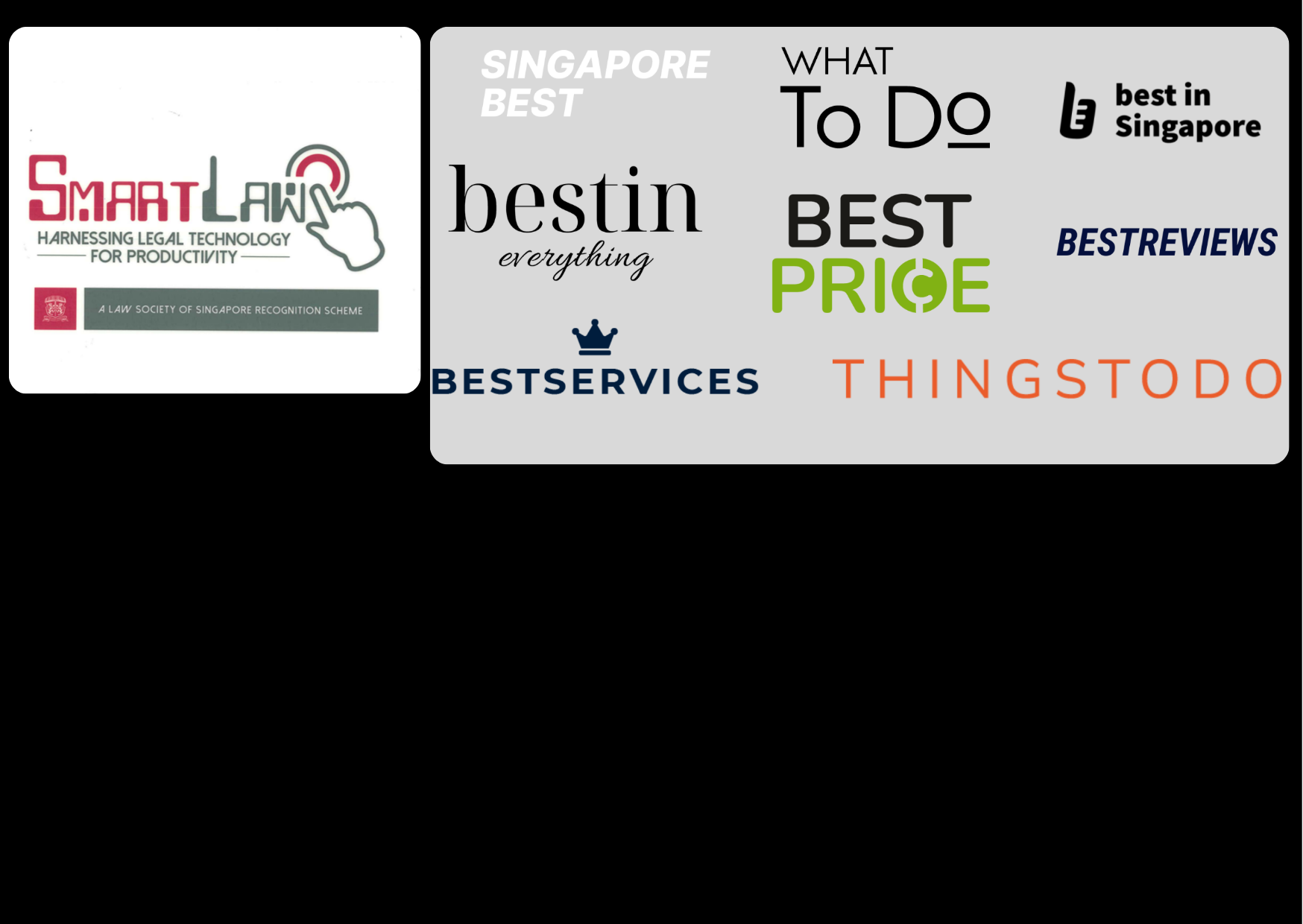Article from DLLC May 2023 Newsletter
Unlocking Business Longevity: A Step-by-Step Guide to Building a Robust Dispute Resolution framework in Your SME
Introduction:
Being involved in a court case fighting for your rights whether for debts, contracts, tenancy or products is not the most glamorous part of doing business, but it is definitely one of the most critical aspects that will need your attention.
In 2021, The Supreme Court received 14,026 new civil and criminal matters of which 13,538 were related to civil matters.There were 191,086 cases filed in the State Courts of which 29,245 were for civil cases.
Unfortunately, businesses cannot adopt the mentality that “litigation won’t happen to us” to ignore the dispute resolution process in Singapore. At some time in your business, you may be faced with a legal dispute.
Business disputes, if not managed properly, can drain time and cash resources, disrupt operations, and tarnish reputations. As such, understanding the process and techniques of dispute resolution in Singapore is crucial, especially for Small and Medium Enterprises (SMEs).
Here’s an in depth step-by-step guide to help bulletproof your business against disputes.
Overview of the Singapore Court Structure:
Let’s start with a brief background of an overview of the Singapore Court Structure.
Supreme Court
The Supreme Court of Singapore consists of the apex Court of Appeal and the Appellate Division of the High Court (which hears appeals against the decision of the High Court).
The General Division of the High Court which hears cases where the claim amount exceeds $250,000 (and appeals from the District Courts and Magistrates Courts); and the Singapore International Commercial Court designed to deal with international commercial disputes.
State Courts
Small Claims Tribunal and Employment Tribunals
The State Courts of Singapore consists of the District Courts and the Magistrates Court. The claim amount determines where the court case is commenced. For a claim less than $250,000, it would be commenced in the District Court and for less than $60,000 it would be commenced in the Magistrates Court.
For matters up to $20,000 and within a list of specific issues, this would be heard in the Small Claims Tribunals. If it is an issue related to employment and the amount does not exceed $20,000, it would be heard at the Employment Claims Tribunal.
Step 1: Understand the Singapore Legal Landscape
Familiarize yourself with Singapore’s dispute resolution landscape.
Singapore is known for its robust legal system with a fair and reliable judiciary. It offers a wide range of dispute resolution methods including litigation, arbitration, and mediation.
Litigation Process
In the litigation process for civil matters, the procedures are prescribed and rigorous. There is a fixed set of rules on the commencement of actions in the Courts and the type of documents to be filed known as “pleadings”. Once an action is commenced in the Courts, parties or their lawyers would have to attend regular case conferences to update the Courts on the issues and progress of the matter.
The parties would be required to produce relevant evidence and documents to support their case with the filing of sworn documents (what is known as “AEICs”).
The Court Process
Ultimately, all these documents and statements are meant to be assessed by a Trial Judge who will then weigh the evidence and the credibility of the witnesses before giving a decision (known as a “Judgment”).
Preparation of AEICs and attending Court is a time-consuming activity because witnesses may have to appear in Court for days and be prepared to be cross-examined by the opponent’s lawyers. The experience for some can be quite terrifying and upsetting.
Matters in the Singapore Courts are generally open to the public and judgments of the Courts available for public view. The judgments of the Courts are subject to appeal except for certain narrow circumstances where they are not appealable.
Arbitration
Arbitration, on the other hand, is a method of private, binding dispute resolution which is agreed between the parties usually by way of an agreement. You will commonly see model arbitration clauses included in your business agreements which would typically set out where should the arbitration take place and the choice of the arbitrator(s).
Sanctity of Confidentiality
The key feature in opting for arbitration is that your case is not displayed in public but kept confidential and away from the public eye.
The award from the arbitration is also final and binding in that there is no right of appeal except for certain limited circumstances.
It also has the mechanism for the award to be enforced in multiple jurisdictions if the participating country has accepted the New York Convention.
World-Class Arbitration Structure
Singapore is usually chosen as the seat of arbitration meaning that arbitration is conducted in Singapore because of its geographic location. It is a hub for legal services in the Asia Pacific region.It has a world-class infrastructure namely the Singapore International Arbitration Centre located at Maxwell Road which supports arbitration with regular updates to Singapore’s legislation to improve its status.
According to an International Arbitration Survey by White & Case/Queen Mary University in 2021, Singapore was the joint most preferred seat for international arbitration in the world along with London. Hong Kong was placed third.
Mediation
Mediation, contrary to litigation and arbitration, is a non-binding process to resolve conflicts and solve problems with the assistance of a neutral third party. It is an effective tool to avoid parties entering into an expensive resource-draining legal battle either through litigation or arbitration.
Mediation allows parties to speak freely and to identify the key issues quickly. The discussions are completely confidential and conducted on a “without prejudice basis”.Nothing that is discussed in mediation can be disclosed to the hearing Judge should mediation fail. It helps parties to come to terms promptly, always with the interest of saving time and cost for all parties.
A successful mediation results in a settlement agreement being entered into between the parties. A non-successful mediation would at least help the parties narrow the issues and carefully assess the true merits of their case.
Arbitration and mediation, collectively known as Alternative Dispute Resolution (ADR), have become increasingly popular for their confidentiality, speed, and cost-effectiveness.
Step 2: Identify Potential Disputes in Your Business
A Dutch Philosopher, Desiderius Erasmus in the 1500s coined the phrase
“Prevention is better than cure” because it saves us from harm instead of curing with medicine. Similarly, in legal matters, prevention would avoid a serious drain on SME resources (which are already very strained and saved on the business).
Therefore it is necessary to regularly review your business operations to identify potential dispute hotspots. These could be anywhere from contract negotiations, payment terms, to partnerships, and client relationships. Have a system in place to identify disputes, review agreements to avoid ambiguity and actively monitor delinquent debts.
Having a system in place also means that all your material contracts are indexed, filed, digitally scanned and stored properly so that designated multiple parties are able to refer to these contracts when needed. With a complete digital copy, it will ensure that multiple parties from different departments are able to read and comment on them.
By identifying potential disputes, you can address issues proactively before they escalate.
Step 3: Draft Clear Contracts
Unclear contracts are a common source of disputes. Ensure that all contracts, whether with customers, suppliers, or partners, are clear and unambiguous. They should spell out the rights, duties, and responsibilities of all parties involved. If necessary, seek the help of a legal professional to draft or review your contracts.
Pay particular attention to the clauses relating to the governing law, jurisdiction, the seat of arbitration and the termination clauses.Look out for clauses which refer to separate documents or websites setting out fuller terms and conditions as these terms and conditions could form part of your contract and be detrimental to you if you have not already reviewed them before.
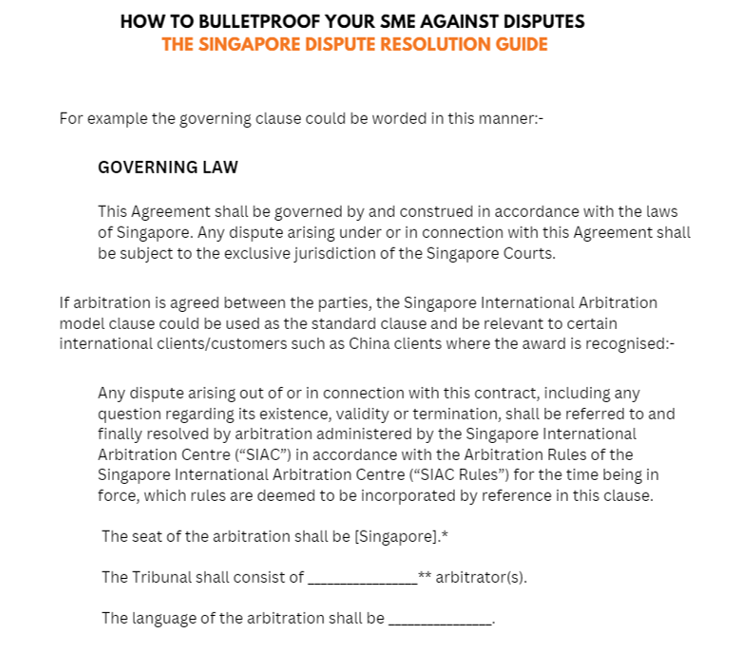
Change No. 2 – Core Provisions to Extend to ALL Managers and Executives (“M&E”)
Step 4: Establish an Effective Complaint Management System (Especially for Employees/Employers)
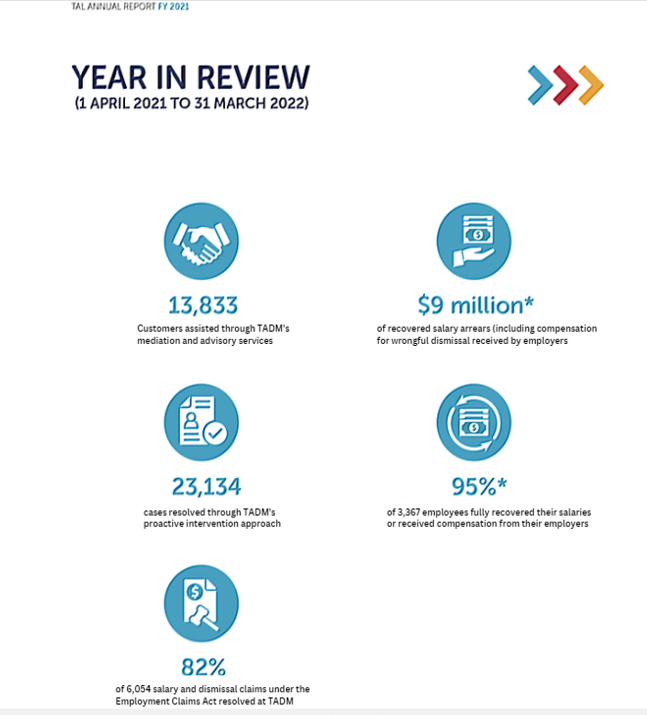
From 1 April 2021 to 31 March 2022, there were a total of 13,833 employment-related cases filed where the Tripartite Alliance for Dispute Management (“TADM”) assisted clients in resolving the disputes and advising on resolution. There were a further 23,234 cases which were resolved through TADM’s proactive intervention approach with 95% of success rate for employees recovering their salaries or receiving compensation from their employers.
The bottom line of these statistics is to bring to your attention that employee/employer resolution starts with mediation and most get resolved at the mediation stage. Why not start off this process in your SME instead of having your employee complaining at TADM?
Disputes often arise out of unresolved complaints usually from employees for 3 key areas. They are namely salary disputes from employees for non-payment, overtime pay or for wrongful dismissals. For employers, it is usually for an employee failing to give the requisite notice before leaving.
With the help of your HR personnel, you could set up a mechanism such as grievance procedure with clear rules on who to report to and how to raise a complaint and when the matter would be heard if there is a complaint. These procedures should be stated transparently in your Employment Handbook to receive, track, and handle complaints effectively. This system should then allow for the early detection of problems and a prompt response, which can prevent disputes from escalating to TADM thereby saving time and effort.
Step 5: Engage in Constructive Negotiation
The art of negotiation is an essential skill in dispute resolution. Here is a framework that SMEs can apply for an effective solution.
In a negotiation, you will need to manage the subject matter of your dispute, the various persons connected to the disputes and the process of the negotiation without which negotiations could fail at inception.
3 Reasons Why Negotiations Fail
Negotiations fail largely due to these 3 constraints namely structural, transactional or interpersonal.
Structural failure is due to parties not being able to agree on the legal issues or disputes. Concessions will be necessary so that parties can see the different views of the issues.
Transactional failure is due to parties refusing to move from their figures or the proposed counter-proposals are deemed too low or demeaning. Often, the company forgets that there is a cost for going to trial or the cost of setting aside their managers and staff to continue the legal battles. If you add the costs of going to a battle to your cost of negotiation, it is likely you will see that settlement would have been the better option than battle, although sometimes for good reasons, battles may be necessary.
Interpersonal relationships can be challenging to manage if the mindset of the parties involved is to not compromise.The strategy for possible success is to use an interests-based approach to solve the issues.
3 Types of Negotiators
According to McClelland’s Need Theory, the psychologist believed that the specific needs of the individual are acquired over a period of time and get shaped with one’s experiences in life. McClelland identified three basic motivating needs i.e the need for power, need for affiliation and the need for achievement. These needs also groom the types of negotiators.
The Power Negotiator
The “power” negotiator is focussed on control and the goal is to win over someone else or score a unilateral gain. The approach is a win-or-loss mentality. The strategy will be to be difficult, get the other side to make an initial offer and set high and uncompromising figures.The “power” negotiator will rely on legal rights, status and circumstances to try and win the argument.
The Affiliation Negotiator
The “affiliation” negotiator derives satisfaction from being loved and accepted by all and tends to avoid the pain of being rejected. This negotiator will try to find buy-ins from the other side and find common grounds for settlement to occur and would at most times maintain a pleasant disposition.
The Achiever Negotiator
The “achiever” negotiator likes to take moderate risks but calculated risks while negotiating. This negotiator would want to obtain immediate feedback on assessing the progress towards the goal. The target is the goal and will not rest until the goal is met.
The traits of one style of negotiation may be more dominant in a person and usually most tend to have a combination of these qualities when negotiating.
Having a competent negotiator would mean that he understands his opponent’s level of effectiveness and motivation simply by understanding the three basic needs. The competent negotiator finds the best method to overcome hurdles and reach a successful settlement.
In summary, when a dispute arises, a competent negotiator approaches it with a problem-solving mindset. The focus is on the interests of all parties, rather than rigid positions, to reach mutually beneficial solutions.
Step 6: Utilize Alternative Dispute Resolution Methods
As explained above, consider using ADR methods when disputes arise. Mediation, a facilitated negotiation process, often leads to win-win outcomes and preserves business relationships. Arbitration, on the other hand, offers a binding resolution in a private and confidential setting.
Step 7: Seek Legal Advice When Necessary
While ADR methods can resolve many disputes, sometimes legal action becomes inevitable. In such situations, consult with a legal professional experienced in dispute resolution. They can guide you through the process and represent your best interests. You do not have to wait till your disputes spill over. Sometimes, seeking early legal advice could help.

Conclusion – Bullet-Proofing Your System from Potential Legal Case
Building a robust dispute resolution framework is no small task, but the benefits are substantial. Not only does it help safeguard your SME against disruptive disputes, but it also contributes to business longevity by fostering strong, harmonious relationships with partners, customers, and suppliers.
It is about creating a culture of transparency, open communication, and mutual respect—a culture that turns potential disputes into opportunities for learning, growth, and improvement. It’s about making your SME not just dispute-resistant, but truly bulletproof.

